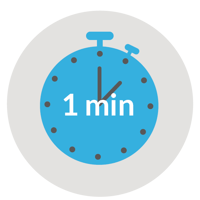Wondering how long should a video be, it’s as asking the question: how long a human can be focused? Today this question is all the more pertinent as our increasingly multi-tasking functions and easy access to any information at any time, have transformed our concentration skills.
Here some examples to optimize the time of your MOOCs’ eLearning videos
1. Be brief
As stated above, human concentration has its limits. The ideal is therefore to remain synthetic in its presentations, easy to say right? But in reality I assure you, it is not so complicated, there are several tricks to keep in mind:
- Enrich your videos: To avoid mentioning an example or a parenthesis that could lengthen your video, integrate comments, attachments or external links. Your video will be interactive and shorter, engaging the learner in his / her learning. Indeed, you offer the possibility of being actively learning.
- Divide your video into several micro videos: even if the small videos are only 1 to 5 minutes long. The attention will be optimized as the learner will be able to rest between each video and be more receptive. It is recommended not to exceed 20 minutes per video, at the risk of losing its audience. In addition, eLearning training will always be shorter than face-to-face trainings. The traditional duration of a day of face-to-face training (6 to 7 hours) is not due to pedagogical relevance but to organizational constraints. An eLearning course is by definition more condensed.
Quoi qu’il arrive, il est recommandé de ne pas excéder 20 minutes par vidéo, au risque de perdre son audience en cours de route. Par ailleurs une formation eLearning sera toujours plus courte qu’une formation en présentiel. La durée classique d’une journée de formation présentielle (6 à 7h) n’est pas dût à une pertinence pédagogique mais bien à des contraintes organisationnelles. Un cours eLearning est par essence plus condensé et va à l’essentiel.
2. The importance of the content
The interest is also challenged by the quality of the content. Here are the aspects to reinforce if you want to ensure impacting eLearning modules:
- Interactivity: making an interactive video engages learners and therefore involves them more effectively in their learning process. Questionnaires or surveys during the video to test their knowledge, a YouTube link to give an example of application, a Wikipedia link to explain an expression … these are all ways to make your audience active in the learning process.
- Language: be careful of scientific worlds! If you use too complicated and academic words you might lose your learners. Nobody wants to follow a video by “pausing” every minute to do a Wikipedia research. The ideal is to remain simple in the speech.
- The graphic aspect: a pleasant appearance is important. Do you want more tips to make your slides more impactful? No problem it’s over here. Do you want to know how to optimize your image on video? We have the answer too 😉
- Storytelling: in marketing it is about creating a story around a product, service or company. We all like to listen to stories, at least we prefer this to a monotonous and boring conference. Tell a story through your courses.
- The subject: must be interesting. This seems obvious but today in the era of zapping, we do not hesitate to pass on things that interest us the less. Here, even if the goal of the lesson is to train on a not-very-funky computer software, make it interesting by going straight to the point, presenting directly what are the benefits to use it and scenarios of applications for an easier appropriation.
Now, how to estimate the time of a video?
|
|
Count the number of wordsThe number of words can be a good way to estimate the time of your module. We count about 1 minute for 130 words. However do not forget:
|
|
So the ideal length of your video is the time it takes to include:
- An attractive content
- An accessible speech
- Interactivity and learner engagement
All these elements explain the success of interactive videos, a new way to communicate that it is important for you to test and master.

 by:Laura Schmitz on: June 1, 2017
by:Laura Schmitz on: June 1, 2017



-2.png)
